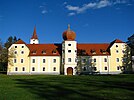County in Croatia
County in Croatia
Požega-Slavonia County (Croatian : Požeško-slavonska županija [pôʒeʃko-slǎʋoːnskaː ʒupǎnija] Croatian county in western Slavonia . Its capital is Požega . Its population was 78,034 at the 2011 census.
Alongside the City of Zagreb and Bjelovar-Bilogora County , it is one of three Croatian counties that do not border another nation.
Geography
Požega-Slavonia county borders on Bjelovar-Bilogora County in the northwest, Virovitica-Podravina County in the north, Osijek-Baranja County in the northeast, Brod-Posavina County in the south, and Sisak-Moslavina County in the southwest.
Administrative divisions
Požega-Slavonija County is divided into:
Municipality
Area (km2 )
Population (2011 census)
Settlements
Brestovac
279.53
3,726
Amatovci • Bogdašić • Bolomače • Boričevci • Brestovac • Busnovi • Crljenci • Čečavac • Čečavački Vučjak • Daranovci • Deževci • Dolac • Donji Gučani • Gornji Gučani • Ivandol • Jaguplije • Jeminovac • Kamenska • Kamenski Šeovci • Kamenski Vučjak • Koprivna • Kruševo • Kujnik • Mihajlije • Mijači • Mrkoplje • Novo Zvečevo • Nurkovac • Oblakovac • Orljavac • Pasikovci • Pavlovci • Perenci • Podsreće • Požeški Brđani • Rasna • Ruševac • Sažije • Skenderovci • Sloboština • Striježevica • Šnjegavić • Šušnjari • Vilić Selo • Vranić • Zakorenje • Završje • Žigerovci
Kaptol
90
3,472
Alilovci • Bešinci • Češljakovci • Doljanovci • Golo Brdo • Kaptol • Komarovci • Novi Bešinci • Podgorje • Ramanovci
Čaglin
179
2,723
Čaglin • Darkovac • Djedina Rijeka • Dobra Voda • Dobrogošće • Draganlug • Duboka • Imrijevci • Ivanovci • Jasik • Jezero • Jurkovac • Kneževac • Latinovac • Migalovci • Milanlug • Mokreš • Nova Lipovica • Nova Ljeskovica • Novi Zdenkovac • Paka • Ruševo • Sapna • Sibokovac • Sovski Dol • Stara Ljeskovica • Stari Zdenkovac • Stojčinovac • Veliki Bilač • Vlatkovac • Vukojevica
Velika
154
5,607
Antunovac • Biškupci • Bratuljevci • Doljanci • Draga • Gornji Vrhovci • Kantrovci • Klisa • Lučinci • Markovac • Milanovac • Milivojevci • Nježić • Oljasi • Ozdakovci • Poljanska • Potočani • Radovanci • Smoljanovci • Stražeman • Toranj • Trenkovo • Trnovac • Velika
Jakšić
43.70
4,058
Bertelovci • Cerovac • Eminovci • Granje • Jakšić • Radnovac • Rajsavac • Svetinja • Tekić • Treštanovci
Demographics
Population pyramid of Požega-Slavonia County per 2011 Census.Historical populations of Požega-Slavonia County Year 1857 47,877 — 1869 53,532 +11.8% 1880 54,183 +1.2% 1890 68,101 +25.7% 1900 79,141 +16.2% 1910 91,272 +15.3% 1921 91,076 −0.2% 1931 99,657 +9.4% 1948 89,646 −10.0%
Year 1953 94,761 +5.7% 1961 99,340 +4.8% 1971 101,745 +2.4% 1981 99,096 −2.6% 1991 99,334 +0.2% 2001 85,831 −13.6% 2011 78,034 −9.1% 2021 64,420 −17.4%
Source: Naselja i stanovništvo Republike Hrvatske 1857–2001 , Croatian Bureau of Statistics , Zagreb, 2005
As of the 2021 census, the county had 64,420 residents. The population density is 35 people per km2 .
Ethnic Croats form the majority with 90.4% of the population, followed by Serbs at 6.0%.[ 4]
Politics
Minority councils and representatives
Directly elected minority councils and representatives are tasked with consulting tasks for the local or regional authorities in which they are advocating for minority rights and interests, integration into public life and participation in the management of local affairs.[ 5] 2023 Croatian national minorities councils and representatives elections Serbs of Croatia fulfilled legal requirements to elect 25 members minority council of the Požega-Slavonia County while Albanians , Czechs , Hungarians and Italians of Croatia elected individual representatives.[ 6] [ 6]
See also
References
External links
Towns Coat of arms of Požega-Slavonia County Municipalities
45°18′40″N 17°44′24″E / 45.311°N 17.740°E / 45.311; 17.740













